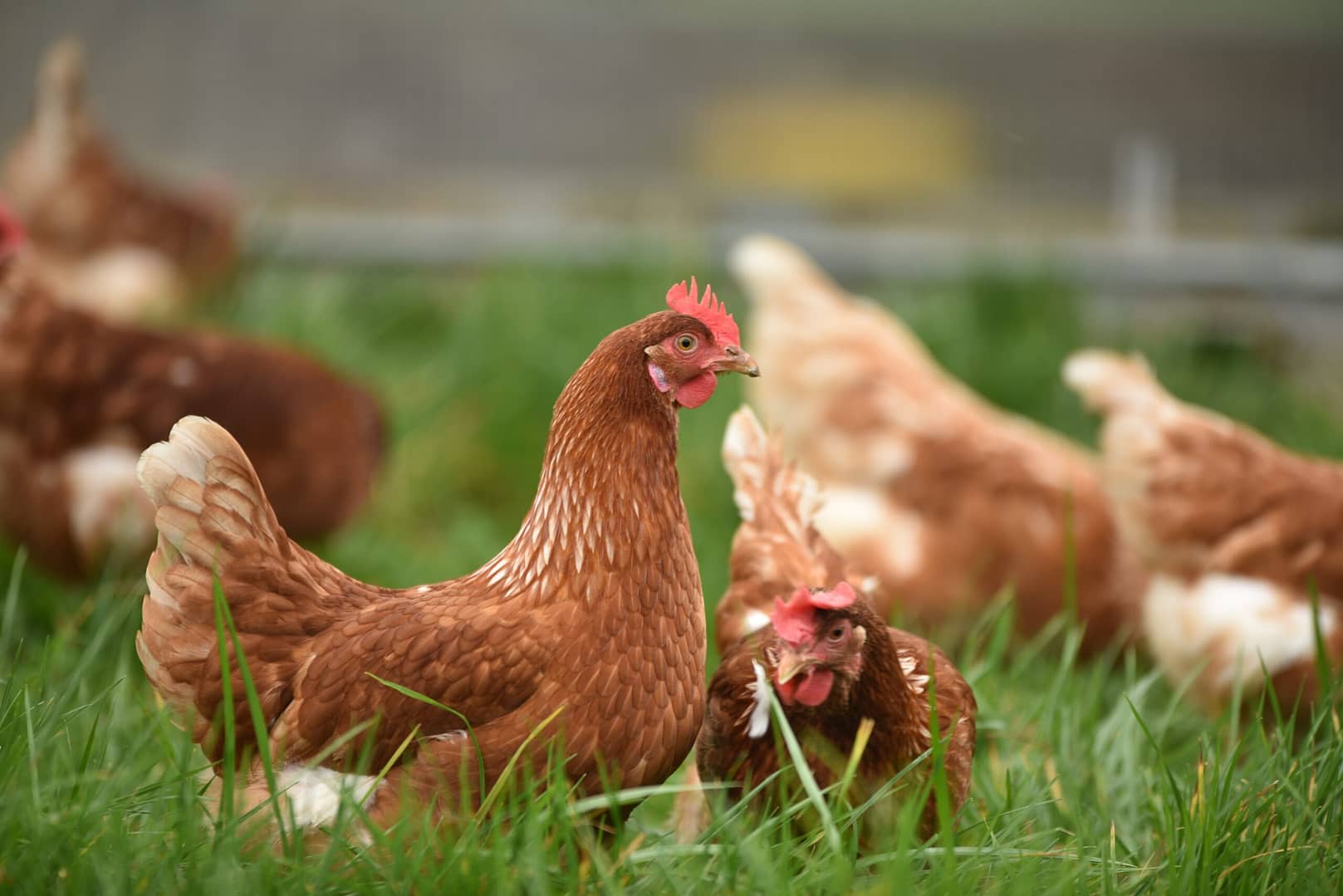Protein sources are important for our chickens. The store-bought feed that we give to our Chickens is always formulated to provide our chickens with the balance of nutrients that they need for daily activities, including egg-laying. Among these nutrients are calcium, carbohydrates, fat, vitamins, minerals, and of course protein.
While each brand of feed will have slightly different nutritional values, for the most part they are similar in the percentage of nutrient amounts provided. And undoubtably, protein is one of the most important of these ingredients.
Why do chickens need protein?
Just like in humans and other animals, protein plays an important role in supporting muscle growth, tissue maintenance, immune system functions, digestive systems, and many other biological factors. (it’s pretty darn important!)
Chickens, of course, need protein for these regular functions, but also need protein for a couple special functions including both egg and feather production.
Why should you feed your chickens additional protein?
Your chickens regular layer feed will typically contain about 15%-17% crude protein at minimum.
While this is plenty of protein to support your chickens’ regular daily needs, they can greatly benefit from additional protein during times when they’re young, molting, extra active (in movement or egg production), during winter, potentially stressed from a new environment, or injured.
Young Chickens – A starter/grower chick feed or feed meant for game birds such as quail or turkeys will generally have higher percentages (18%+) of protein. Young chicks need this extra protein to help grow (and grow they will, super fast!). Once they reach adulthood the level of protein usually lowers to about 16% on average.
Molting – Once they’ve reached adult-chicken-hood, your chickens should start molting once a year. They’ll lose about half of their feathers and regrow new ones. While molting they’ll look quite the mess, but once they grow back their feathers, they’ll be looking like brand new! Feathers contain mostly keratin, a type of protein. Providing your chickens extra protein during molt season is especially helpful in feather regrowth and keeping your chickens healthy.
Winter – During colder months having extra protein in their diet helps your chickens maintain their feathers and feather growth (the same reason they need extra protein during molting). It also helps them maintain their muscle during a time of year when they’re not as physically active and helps build healthy fats which helps keep them warmer.
Extra Activity – Chickens metabolize and use protein for various daily functions including bodily functions such egg production and simply moving around. If your chickens free-range, then they’re typically staying fairly active. If they’re able to eat a lot of protein in the form of worms and insects, then that’s great because the extra protein will help
Stress – Stress can cause a lot of different health issues in chickens. Being moved to a new location, having new chickens introduced to the flock, or a recent predator attack attempt can all be stressful situations for a chicken.

Healing from injuries – Not only are chicken feathers are made up of the protein keratin, but so are their beaks and claws. If your chickens have somehow injured their beaks or claws then extra protein in their diet will help them with the healing process.
How much protein can you give your chickens?
Most layer feeds contain about 15%-17% crude protein, when providing extra protein to your chickens, aim to only give them a couple extra percentages – about 20% max. Too much protein in their diet could cause health issues. Also remember that snacks should be kept to about 10% or less of their daily diet with formulated feeds accounting for the other 90%.
Best Protein Sources for your Backyard Chickens
-From the Kitchen & Pantry-
01 Leftover Beef, Pork, Poultry, & Seafood – If you have any meats leftover from dinner then feel free to give them to your chickens as a snack. Leftover bones with bits of meat, overcooked/undercooked cuts, shrimp bits, or anything else you’re willing to share with your chickens is game (yes, even leftover chicken).
Try to avoid giving them anything fried or particularly greasy. While they can eat greasy fried foods… it’s just not very good for them.
One thing to note is that chickens won’t typically eat bones, just the meat and bits off the bones. If giving your chickens bones with meat on them, make sure to pick the leftover bones up after a while and toss them in the trash.
02 Canned Meats – Canned tuna, salmon, chicken etc. can be a great source of protein for your chickens, albeit a bit expensive if you’re buying cans solely for your chickens’ consumption.
Sometimes cans of salmon will come with the bones intact… while they’re soft and perfectly edible, I like to pick them out and give them to my chickens for a snack.
03 Cooked Eggs – Eggs are a great source of protein for all humans and protein-eating animals alike. A boiled egg contains about 17 grams of protein making it one of the best sources of protein readily available to give to your chickens (since they’re literally producing the eggs for you).
I recommend not feeding eggs to your chickens raw. There’s potential your chickens could start eating their own eggs, which you never want (it’s wasteful and messy) and there’s also the possibility of bacteria from the egg being passed to the chicken.
And of course, don’t feed your chickens back any eggs that could possibly be bad as you don’t want to accidentally make them sick. Best Ways to Tell if Your Chicken Eggs are Good or Bad (Ultimate Guide)

04 Plain Greek Yoghurt – While giving your chickens large amounts of dairy isn’t good for them, providing sugar-free Greek yoghurt is fine to do in small amounts and will give them a protein boost (plus they love it). Just like in human stomachs, probiotics in yoghurt can help your chickens build up good bacteria in their digestive systems. Don’t feed any of the sugary yoghurts with flavor additives etc. And keep in mind that chickens eating yoghurt can be a messy affair.
05 Cat/Dog Food – while you wouldn’t want to feed your chickens cat or dog food in place of their regular feed, it’s perfectly fine to provide in small amounts as a snack. Both cat and dog foods are high in protein and often readily available since so many of us have cats &/or dogs.
-Plant Proteins-
Some vegetables aren’t just full of vitamin and nutrient goodness, some also contain protein and make for excellent snacks for giving a protein boost for your chickens.
06 Cooked Beans & Lentils – Kidney beans, pinto beans, black beans, soybeans, lentils etc. all contain decent levels of protein. Feel free to feed these to your chickens in limited amounts (keeping in mind snacks should only make up less than 10% of their diet).
NOTE: You should NOT feed your chickens dried or raw beans. In their dried or raw form, beans contain a harmful toxin called phytohemagglutinin which can be fatal to chickens and other poultry. When cooked at high temperatures this toxin goes away and becomes safe your chickens so make sure any beans given are soaked (if originally dried) and then cooked at high heats for at least 30 minutes. It’s also good to dump out the soaking water and get fresh and possibly rinse the beans off again after cooking (just to be safe).

07 Grains – Grains like quinoa and oats are also packed with protein and well loved by chickens. These don’t need to be cooked first, but they do expand once in the body so make sure you’re only giving your chickens a bit at a time.
08 Peas – Peas contain relatively high levels of protein and are also cheap to buy in the store and easy to grow yourself. There’s about 8 grams of protein in 1 cup of peas. Your chickens only need a little extra protein to help with feather growth during molt season, so 1 cup of peas per about 6 chickens should be plenty. Cold/frozen peas also make for a great snack during summer and are small enough they’re easy for your chickens to digest.
09 Seeds – Seeds from plants such as sunflower, pumpkin, flax, and chia seeds contain protein as well – typically anywhere between 4.0 – 9 grams of protein per oz. Toss these seeds on the ground like scratch, combine into their regular feed, or add to a suet mixture to incorporate into your chicken’s diet.
-The Creepy & the Crawly-
10 Mealworms – I could group mealworms with other insects or creepy crawlies, but they are much more marketed and readily available in stores as compared to other store-bought bugs. You can get them freeze dried like crunchy little bug chips, or as fresh wriggly worms (yum!).
If you’re feeling adventurous you could even try managing your own mealworm farm so you have a constant supply of fresh mealworms for your hens and roos.
11 Earthworms – If you’ve got good soil on your property, chances are you’ll have some earth worms hanging about as well. When foraging, your chickens will scratch and dig out worms themselves, but if you’re doing some gardening work, then you can also unearth worms and toss them to your chickens.
Just like you can raise and grow mealworms yourself, so can you with earthworms. Although by simply having a compost pile you’re pretty likely to attract some to your yard. If you live in a drier area where earthworms are more scarce, you can always pick up a tub of them from a pet or fishing store.
12 Insects – Your chickens will naturally forage for insects to eat throughout the day as they wander your property. From flies to ticks to moths, they’ll eat whatever catches their eye.
There are some bugs your chickens may not be interested in. Mine won’t touch ants and don’t even bother going after anything that flies fast or is particularly small. Cicadas, beetles, cockroaches, spiders, etc are all fair game though.
If you want, you can set up jar traps for certain bugs and then toss the jars in for your chickens to enjoy. Spiders can be caught in glass jars by setting some jars up in corner areas where spiders might be roaming (they crawl in from wall corners and then can’t climb back out of the glass).
13 Mice, Rats, and Reptiles – While the thought of mice, rats, and reptiles might give you the heebie-jeebies, chickens can enjoy these creatures as snacks, so long as they’re a small enough size they can eat them. There are plenty of videos around the web of chickens running around eating such critters.
14 Animal Carcasses – while it may seem like a gross concept to many, chickens are natural little scavenging predators and will often eat what’s available. If you happen to have or find an animal carcass, if you give it to your chickens, they’ll dig in. The idea of giving your chickens roadkill to supplement their feed is more of a hardcore permaculturalist idea, but anyone can implement it so long as they don’t mind rotten carcasses sitting in their backyard. You don’t want to feed anything that’s too far gone or fully rotten though – leave that for the buzzards.
Conclusion
- Chickens can benefit greatly from some added protein to their diet during molting, illness, and times of stress (from being moved etc).
- Some of the best sources of protein snacks are worms, bugs, meats, seeds, and grains.
- Too much protein isn’t good for your chickens. Only aim to add a couple extra grams to their diet each day when needed. Snacks and supplements should not exceed 10% of their daily diet (the rest being formulated feed).

